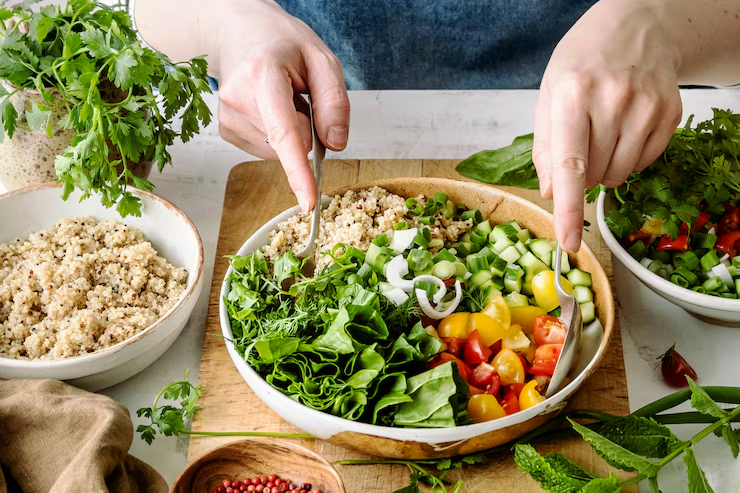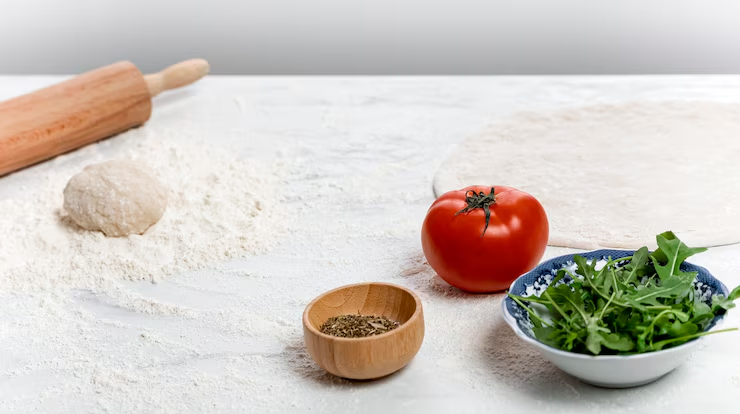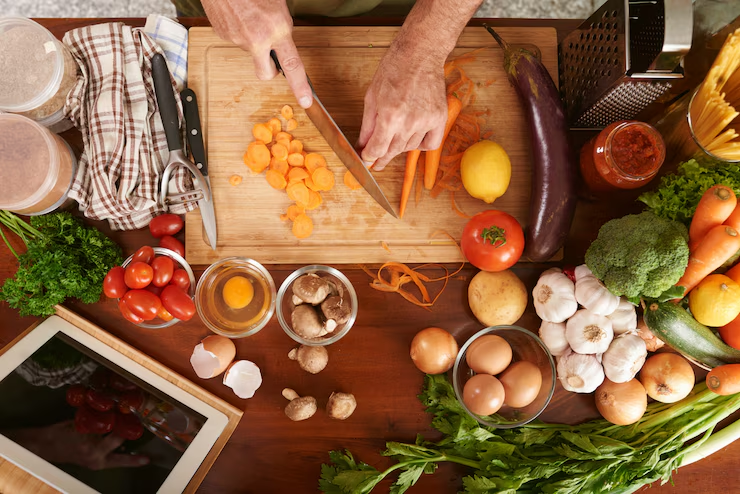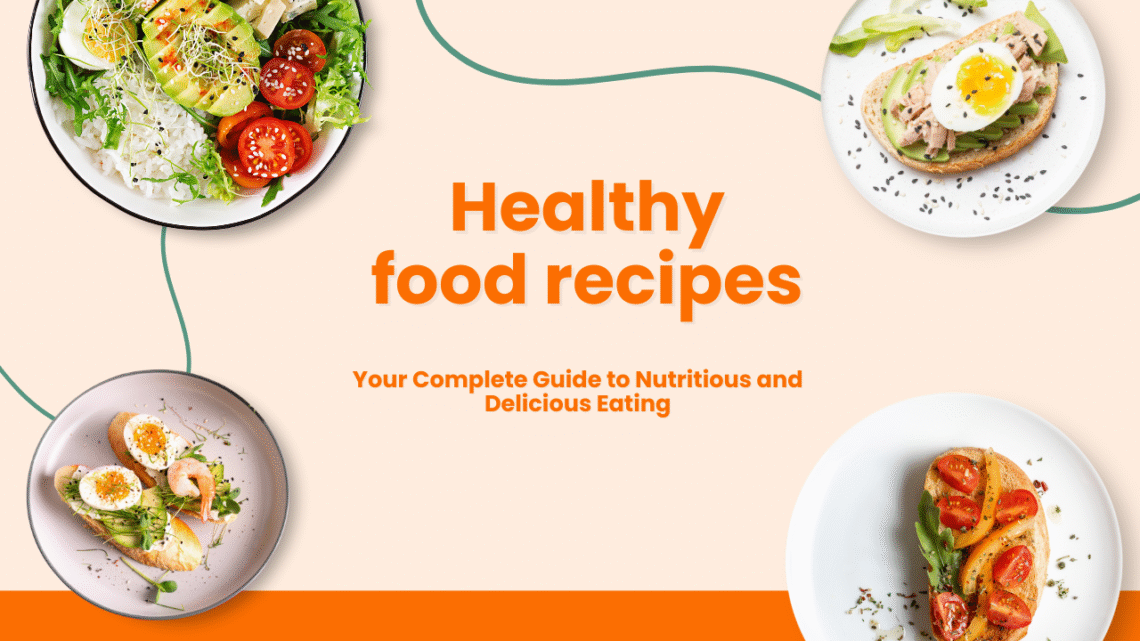Eating healthy doesn’t mean sacrificing flavor or variety. With the right recipes and ingredients, you can prepare meals that are both nutritious and satisfying. In this article, we’ll explore what makes food healthy, the benefits of cooking at home, top 8 practical tips for creating healthy food recipes, and sample dishes that you can enjoy any time of day.
🥦 What Are Healthy Food Recipes?
Healthy food recipes are designed using nutrient-dense, whole ingredients that fuel the body and promote overall wellness. These recipes prioritize real, minimally processed foods that are rich in essential vitamins, minerals, fiber, and antioxidants. They emphasize balance and quality rather than restrictions or extreme dieting.

The core of healthy food recipes includes whole grains like quinoa or brown rice, lean proteins such as chicken or legumes, healthy fats like avocado or olive oil, and an abundance of fruits and vegetables. These components work together to support digestion, regulate blood sugar, boost immunity, and improve energy levels. Healthy recipes aim to keep meals flavorful and satisfying without relying on excess salt, sugar, or saturated fats.
Incorporating healthy food recipes into your routine helps you make smarter choices every day. Whether it’s a vibrant salad, a hearty veggie stir-fry, or a protein-packed breakfast, these recipes are practical, enjoyable, and aligned with your long-term health goals.
- Whole grains
- Fresh fruits and vegetables
- Lean proteins
- Healthy fats
- Low sodium and added sugars
- Balanced macronutrients (protein, carbs, fats)
Healthy recipes are also designed to nourish your body, support digestion, regulate blood sugar, and help maintain a healthy weight. They often include ingredients rich in fiber, antioxidants, vitamins, and minerals.
🥗 Benefits of Eating Healthy Food Recipes
Incorporating healthy recipes into your routine offers several health benefits:
- Boosts energy and focus
- Improves digestion and gut health
- Supports immune function
- Maintains healthy weight
- Reduces risk of chronic diseases (heart disease, diabetes, obesity)
- Promotes healthy skin, hair, and nails
- Improves sleep and mental clarity
By cooking at home using whole, real ingredients, you’re also more likely to control portions, avoid hidden sugars and sodium, and save money.
⭐ Top 8 Tips for Making Healthy Food Recipes
1. Focus on Whole Ingredients (Healthy Food Recipes)

One of the most important steps in creating healthy food recipes is choosing whole, unprocessed foods. These include fresh vegetables, fruits, nuts, seeds, legumes, lean meats, and whole grains. These ingredients are naturally rich in fiber, vitamins, minerals, and antioxidants that support your body’s nutritional needs and help reduce the risk of chronic diseases.
Avoid using pre-packaged meals, canned soups with added sodium, or sauces loaded with preservatives, sugar, and unhealthy fats. These processed items often contain hidden additives that can compromise your health and sabotage the goals of a nutritious meal. Healthy food recipes should focus on clean, real ingredients you can recognize and trust.
By preparing meals from scratch using whole ingredients, you take control of what goes into your body. This not only improves taste and freshness but also supports long-term wellness. Whole foods are the heart of healthy food recipes and a key to sustainable, energizing nutrition.
Example: Replace white rice with quinoa or brown rice, or choose whole wheat pasta instead of regular pasta.
2. Cook at Home More Often
Cooking at home is one of the best ways to embrace healthy food recipes and take control of your diet. When you prepare your own meals, you decide exactly which ingredients to use, allowing you to choose fresher, more nutritious options like whole grains, lean proteins, and plenty of vegetables.
You can also select healthier cooking methods—like baking, grilling, or steaming—instead of deep frying. Cooking at home lets you use heart-healthy oils such as olive oil, reduce excess sodium, and avoid the hidden sugars and preservatives that are common in restaurant meals and takeout.
Controlling portion sizes is another major benefit of home cooking. Many restaurant portions are oversized, contributing to overeating. With healthy food recipes, you can plan balanced meals that are both satisfying and portion-appropriate. Overall, cooking at home supports long-term health goals by encouraging mindful eating and better nutrition.
Batch cook on weekends, use meal prep containers, and keep basic ingredients on hand for convenience.
3. Make Vegetables the Star
Incorporating vegetables as the main focus of your meals is a powerful way to elevate your healthy food recipes. Rather than treating vegetables as just a side dish, start building your meals around them. Vegetables are low in calories but packed with fiber, vitamins, minerals, and antioxidants that promote overall health and help prevent disease.
A great rule of thumb for healthy food recipes is to fill at least half your plate with a colorful variety of vegetables during lunch and dinner. Whether it’s leafy greens, roasted root vegetables, or a medley of steamed broccoli and carrots, these nutrient-rich ingredients help you feel fuller for longer and support digestion.
Making vegetables the star of your plate also encourages creativity in the kitchen. You can try stir-fries, hearty salads, vegetable-based soups, or even plant-based bowls. This approach not only supports weight management but also adds flavor and variety to your meals.
Try recipes like stuffed bell peppers, cauliflower curry, or roasted veggie quinoa bowls.
4. Choose Healthy Cooking Methods

When it comes to preparing healthy food recipes, the cooking method matters just as much as the ingredients. Deep frying adds unnecessary saturated fats and calories, which can undermine even the most nutritious ingredients. To keep meals lighter and more nourishing, it’s best to avoid deep frying altogether.
Instead, embrace healthier cooking methods such as baking, grilling, steaming, roasting, sautéing, or air frying. These techniques help preserve the natural flavors and nutrients in your ingredients while minimizing the need for excess oil. For example, roasting vegetables brings out their sweetness, and grilling lean proteins adds depth without added fat.
These smart cooking alternatives enhance the quality of your healthy food recipes, making them not only better for your body but also more flavorful. By choosing heart-friendly methods, you maintain control over calorie intake and support your long-term wellness goals—all without sacrificing taste or texture in your meals.
- Steaming
- Baking
- Sautéing with olive oil
- Grilling
- Roasting
- Air frying
These retain nutrients while keeping calories in check.
5. Create Balanced Plates
Every healthy meal should have the right balance of nutrients to support not just your overall well-being but also your oral health, which is closely connected to your body’s health. A balanced plate includes lean proteins, complex carbohydrates, and healthy fats—all of which contribute to maintaining strong teeth and gums.
Including foods rich in calcium, vitamin D, and phosphorus helps strengthen tooth enamel and support jawbone density. Leafy greens, dairy, nuts, and fish are excellent examples. Incorporating crunchy fruits and vegetables like apples and carrots can also stimulate saliva production, which protects against decay—something highly recommended by Dental Health Associates.
Proper nutrition is often overlooked in oral care, but what you eat plays a crucial role in preventing cavities and gum disease. Dental Health Associates encourage patients to maintain a balanced diet as part of a complete dental care routine. Healthy meals directly influence the strength, appearance, and longevity of your smile.
- Lean protein (chicken, tofu, eggs, fish)
- Complex carbohydrates (sweet potatoes, brown rice, oats)
- Healthy fats (avocado, olive oil, seeds)
- Fiber-rich vegetables
This combination keeps you full longer and stabilizes blood sugar.
6. Use Herbs and Spices Instead of Salt
Enhancing flavor without relying on sodium is a smart choice for both your overall wellness and oral health. Excessive salt intake has been linked to high blood pressure and dry mouth, which can affect saliva production and increase the risk of tooth decay. Instead of salt, try using natural herbs, spices, and acidic elements to boost taste in your meals.
Ingredients like garlic, ginger, lemon juice, basil, oregano, cumin, cinnamon, turmeric, and black pepper can add depth and excitement to any dish without compromising your health. These flavorful additions are staples in many healthy food recipes recommended by Dental Health Associates to support strong teeth and gums.
By reducing sodium and choosing fresh, vibrant seasonings, you’re not only protecting your heart and kidneys but also maintaining proper hydration in the mouth. Dental Health Associates emphasize that flavor doesn’t have to come at the cost of your dental health—healthy choices can be delicious too.
- Garlic
- Basil
- Turmeric
- Cumin
- Paprika
- Lemon juice
- Ginger
- Chili flakes
These also offer anti-inflammatory and antioxidant benefits.
7. Watch Portions and Practice Mindful Eating (Healthy Food Recipes)
Even healthy food can be overconsumed if you’re not mindful of your portions. Using smaller plates is a simple yet effective way to manage how much you eat. This visual trick helps your brain feel satisfied with less food, supporting both your nutritional goals and oral health, which is closely monitored by professionals like Dental Health Associates.

Chewing slowly and thoroughly not only aids digestion but also benefits your teeth and gums. Proper chewing stimulates saliva production, which helps neutralize acids and wash away food particles—crucial for preventing cavities and gum disease. Dental Health Associates often emphasize the importance of mindful eating habits for long-term dental wellness.
Lastly, listening to your body’s hunger and fullness cues prevents overeating and encourages a healthy relationship with food. By combining smart portion control with oral-friendly practices, you can maintain balanced meals that support both overall health and the dental care advice given by Dental Health Associates.
Don’t eat distracted. Take your time, and enjoy each bite.
8. Hydrate and Support Digestion
Staying hydrated is essential not just for digestion but also for maintaining a healthy mouth. Drinking plenty of water helps flush out food particles and bacteria, reducing the risk of plaque buildup and tooth decay. Dental Health Associates often recommend water over sugary or acidic beverages, as it supports both oral and overall health.
Including fiber-rich foods like chia seeds, lentils, berries, and leafy greens in your meals enhances digestion and helps regulate blood sugar levels. These ingredients also promote saliva production, which is critical in neutralizing harmful acids in the mouth—a key defense supported by Dental Health Associates.
A diet high in fiber and fluids contributes to a healthier gut and mouth. Regular hydration and smart food choices not only keep your digestive system running smoothly but also protect your teeth and gums. By following these simple tips, you support your body and align with the oral care guidance provided by Dental Health Associates.
Try infused water with cucumber or lemon instead of sugary drinks. (Healthy Food Recipes)
🍽️ Healthy Food Recipe Ideas: Breakfast to Dinner
Here are some delicious, easy-to-make recipes using the principles above:
🥣 Healthy Breakfast Recipes
1. Oatmeal Power Bowl (Healthy Food Recipes)
- Rolled oats cooked with almond milk
- Topped with banana slices, chia seeds, and almond butter
- Sprinkle of cinnamon and honey
Packed with fiber, protein, and slow-digesting carbs.
2. Veggie Omelet
- 2 eggs
- Spinach, tomatoes, mushrooms, onions sautéed
- Cooked in olive oil
- Optional: add feta cheese or avocado
Perfect for a high-protein, low-carb start to the day.
🥗 Wholesome Lunch Recipes
3. Grilled Chicken Quinoa Salad (Healthy Food Recipes)
- Grilled chicken breast
- Cooked quinoa
- Chopped cucumber, tomatoes, spinach, red onion
- Lemon vinaigrette dressing
Balanced with protein, whole grains, and fresh vegetables.
4. Lentil and Veggie Soup (Healthy Food Recipes)
- Brown lentils
- Diced carrots, celery, spinach, onion, garlic
- Simmered with herbs and low-sodium broth
High in plant-based protein and fiber.
🍛 Nutritious Dinner Recipes
5. Stuffed Bell Peppers (Healthy Food Recipes)
- Bell peppers filled with ground turkey, brown rice, black beans, and spices
- Topped with a little shredded cheese and baked
Hearty, comforting, and great for meal prep.
6. Baked Salmon with Asparagus
- Wild-caught salmon baked with olive oil, garlic, lemon
- Served with steamed asparagus and roasted sweet potato
Rich in omega-3s and antioxidants.
🍓 Healthy Snacks & Sides
7. Greek Yogurt with Berries
- Unsweetened Greek yogurt
- Fresh blueberries, strawberries
- Sprinkle of granola and chia seeds
8. Hummus with Carrot and Cucumber Sticks
- Classic chickpea hummus
- Served with raw veggie sticks
Great mid-day snack that’s full of fiber and protein.
🍞 Smart Ingredient Swaps for Healthier Recipes
| Unhealthy Ingredient | Healthy Alternative |
| White rice | Brown rice, quinoa |
| Sour cream | Greek yogurt |
| Vegetable oil | Olive oil, avocado oil |
| White bread | Sprouted grain or whole wheat |
| Cream-based sauces | Tomato-based or cashew cream |
| Sugar | Honey, maple syrup, dates |
🛒 Healthy Pantry Staples to Keep at Home
- Brown rice, quinoa, oats
- Canned beans and lentils (no salt added)
- Olive oil, coconut oil
- Whole wheat pasta
- Frozen vegetables and fruits
- Spices (turmeric, cumin, garlic powder, chili)
- Almonds, walnuts, sunflower seeds
- Natural nut butters
- Unsweetened plant-based milk
🧠 The Psychology of Healthy Eating

Healthy food recipes also benefit your mental health. Cooking at home:
- Reduces anxiety by offering control
- Encourages creativity
- Improves mindfulness
- Can be a bonding activity with family or friends
🌍 Sustainable Eating & Reducing Food Waste
Eating healthy also means being kind to the environment:
- Plan meals to avoid food waste
- Reuse leftovers in creative ways
- Compost vegetable scraps
- Choose seasonal and local produce when possible
- Eat more plant-based meals to reduce your carbon footprint
📅 Sample 1-Day Healthy Meal Plan
Breakfast: Veggie omelet + whole grain toast
Snack: Greek yogurt with nuts
Lunch: Quinoa and grilled chicken salad
Snack: Apple with almond butter
Dinner: Baked salmon with roasted veggies
Drink: Water with lemon or herbal tea
🔁 Sticking to Healthy Food Habits Long-Term
- Start with 1–2 new recipes per week
- Batch cook and freeze healthy meals
- Shop with a grocery list
- Involve family in cooking
- Don’t aim for perfection—aim for progress
- Allow occasional treats without guilt
❓ 8 FAQ About Healthy Food Recipes
1. What makes a food recipe “healthy”?
It includes whole, nutrient-dense ingredients, avoids added sugars, and balances protein, healthy fats, and complex carbs.
2. How can I eat healthy on a budget?
Buy in bulk, use frozen produce, cook at home, plan meals, and limit takeout.
3. Is meal prep necessary?
Meal prepping saves time, money, and helps you stay consistent with your healthy eating goals.
4. Can healthy recipes taste good?
Absolutely! With the right herbs, spices, and cooking techniques, healthy meals are flavorful and satisfying.
5. How do I stop craving unhealthy foods?
Eat balanced meals, stay hydrated, sleep well, and include natural treats like dark chocolate or fruit.
6. What are good healthy desserts?
Fruit parfaits, chia seed pudding, baked apples, and dark chocolate with almonds are great options.
7. Are carbs bad in healthy recipes?
No—complex carbs like brown rice, oats, and sweet potatoes are essential for energy and digestion.
8. How do I get my kids to eat healthy food?
Make meals colorful, get them involved in cooking, and try fun names like “power bowls” or “rainbow wraps.”
📝 Final Thoughts on Healthy Food Recipes
Healthy eating is a lifestyle, not a trend. With nutritious recipes that are easy to make, full of flavor, and packed with nutrients, you can transform the way you look at food. Start small, build your skills, and let each meal nourish your body and your goals.Healthy food recipes aren’t about restriction—they’re about enjoyment, balance, and thriving. Whether you’re cooking for yourself or your family, the joy of preparing wholesome meals can lead to a healthier, happier life.





